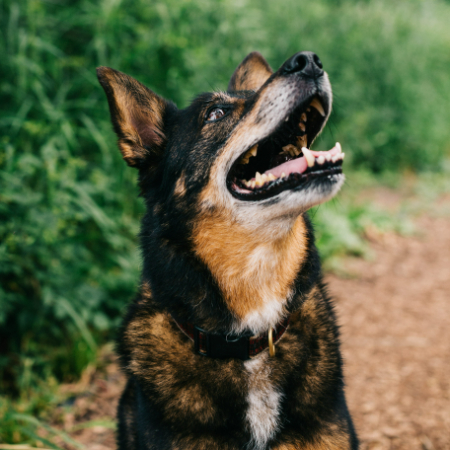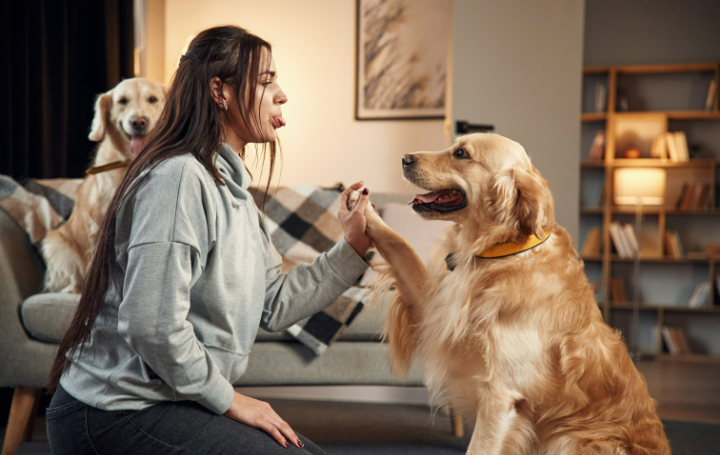How Dogs Communicate with Humans: A Look at Barking, Whining, and Other Vocalizations
Since ancient times, dogs and humans have been best companions for thousands of years, but what really makes this bond unique is how well they communicate. Dogs may not speak as humans do, but they do have a whole language that we may learn to comprehend. Dogs use a variety of vocalizations to communicate their wants, feelings, and desires, including barking, whining, snarling, and howling.
So how are we supposed to interpret what they’re saying? Enter the fascinating realm of canine communication as we examine the various noises they use to communicate with us.
The Bark: A Dog’s All-Purpose Tool
One of the most frequent sounds that dogs make is barking, but did you know that the meaning of a dog’s bark varies depending on the circumstance? Here are a few applications for barking:

1. Aware Barking
This is the traditional bark that says, “There’s something or someone new!” Whether it’s a squirrel scuttling across the yard, the mailman on his way, or a knock at the door, dogs frequently bark to alert you to something strange. It’s their method of admonishing you to pay attention! There’s a problem!
2. Excitement Barking
Dogs may bark out of enthusiasm when they are really thrilled, such as when you take out the leash for a walk or they see one of their favorite toys. Along with wagging tails and jittery behavior, these barks are typically higher pitched. It’s their way of saying, “I’m excited, let’s go!”
3. Make Demands Barking
Demand barking is when your dog barks to seek your attention or to get a treat or food. It is as if they are expressing, “Hey, human, I need something, and I need it now!” Until they receive what they want, these barks are usually repetitious.
4. Terrified Barking
Anxiety or fear are the causes of some barks. When your dog feels threatened or disturbed, it may bark in a more defensive manner. When meeting a new person or being in an unknown place, a dog may bark in this manner. In essence, they’re saying, “I’m not happy with this circumstance. Kindly let it disappear.
5. Jovial Barking
Dogs will frequently bark to maintain a high level of energy during playtime. Friendly body language such as a wagging tail or a “play bow” (front legs down, butt up) is typically displayed along with these barks. All your dog is saying is, “I’m enjoying myself! Let’s continue to play!
Deciphering the meaning your dog is attempting to convey through barking requires an understanding of its context. Is it lighthearted? In defense? grumpy? You can read their body language to figure out what they’re trying to say.
The Whine: When Dogs Want Something (or Are Feeling Emotional)
Whining is another typical vocalization that, although occasionally irritating, frequently indicates an underlying need or emotion. Dogs may whine for the following reasons:
1. Seeks Attention
As children may say, “Mum, mum, mum,” dogs will also cry out for your attention. They can simply want their tummy rubbed, or they might want to go outside. They’re asking to be noticed, in any case.
2. Worry or Stress
When a dog is nervous or agitated, they may whine. This may occur during isolated moments, automobile excursions, or thunderstorms. Your dog is expressing discomfort in these situations and asking for comfort.
3. Pain or Unease
Dogs may whine to alert you to problems if they are hurt or feeling under the weather. They use it as a means of expressing, “I don’t feel good,” and it’s crucial to pay attention to these signs, particularly if they seem unexpected or out of character.
4. Excitement
Certain dogs will cry out when they are extremely happy, such as when they are going on an adventure or when you get home after a long day. For them, it’s a way to express their excitement and enthusiasm and release emotions.
Growling: Not Always as Scary as It Sounds
Due to the common misconception that growling is aggressive, it frequently has a negative reputation. While growling is a useful tool for communication, it can also be a warning message. This explains why dogs growl:

1. Alert or Protective
Dogs communicate with others by growling when they are uneasy or feel threatened. That’s how they say “Get out of my way!” For instance, a growl communicates to another dog, “This is mine, stay away,” if it approaches their food bowl too closely.
2. Joking Growling
During play, particularly in activities like tug-of-war, growling might occasionally occur. The growl in these situations is pleasant and low-pitched. Your dog appears to be enjoying himself as long as his body language is laid back.
3. Fear-Driven Barking
Your dog may growl in self-defense if they sense danger or are cornered. It’s crucial to respect this border because this is more of a “I’m scared, don’t push me” growl. A scared dog may bite if you push them too far.
Howling: The Wild Ones’ Call
Dogs are related to their wolf forebears through the more primitive sound of howling. The majority of domestic dogs don’t howl as much as wolves do, although other breeds—like Huskies and Beagles—do so more often. Your dog may howl for the following reasons:
1. Talking with Other Canines
Dogs communicate over great distances with other dogs by howling. A dog may howl in reaction to hearing another dog howling or barking nearby, even if they are inside the house.
2. Taking Notice of Sounds
Some dogs, upon hearing particular noises, such as sirens, musical instruments, or even a high-pitched voice, will howl. They almost seem to be joining in as the sound sets off their innate urge to howl.
3. Anxiety During Divorce
When left alone, dogs that suffer from separation anxiety may scream. They’re trying to reach out to you, hoping you’ll come back soon. It’s important to look into ways to make your dog feel more comfortable if they howls all the time when you’re not around. This could be an indication of distress.
4. Seeks Attention
Certain dogs will howl to catch your attention, much like they will bark or whine. Perhaps they’ve come to understand that wailing will bring them something from you, like a treat or a reply.
Growls, Howls, and Other Sounds
Dogs create several noises that convey diverse messages besides barking and whimpering. Dogs express themselves in a variety of ways, including growling, howling, sighing, and grumbling.
1. The Growl: Is It Funny or a Warning?
Though it’s frequently associated with anger, growling isn’t always a negative thing. When a dog senses danger or wants someone to go away, it will growl to alert others. Your dog may grumble playfully during a tug-of-war; this is a common occurrence in the game.
It’s crucial to respect your dog’s space, though, if they are snarling at you or other people in an unplayful manner. Your dog is using his growl as a means of expressing, “I’m uncomfortable with this,” and if you ignore it, they may become more hostile.
2. Howl: Unleashing Their Inner Wolves
Among the more enigmatic sounds made by dogs is howling. It’s thought that dogs’ howling is a behavior they learned from their wolf ancestors. Dogs may howl in response to stimuli like sirens or music. Dogs that howl can communicate with other dogs across great distances or as a symptom of loneliness.
It may be worthwhile to investigate whether your dog is bored, lonely, or in need of additional attention if they scream a lot.
3. The moan and complain
Has your dog ever plopped down on the couch and let out a long sigh? Just like humans, dogs sigh when they’re happy, at ease, or even a little bored. If your dog is curled up contentedly after a long day of play, groans or soft growls may also indicate contentment.
Dog Communication Is Mostly Through Body Language
Dogs communicate using body language in addition to vocalizations, as we have discussed. Even more expressive than barking or whining are gestures like a wagging tail, lifted ears, or a cocked head. You can have a better understanding of your dog’s communication by observing their body language and facial expressions.

A dog that exhibits rigidity in its body and direct gaze may be feeling defensive or nervous, whereas a dog that displays relaxation in its body, a loose tail, and soft eyes is most likely content and at ease. When vocalizations and body language are combined, they provide a more comprehensive tale that enables you to comprehend your dog’s needs and feelings.
In conclusion, Pay Attention to Your Dog
Even though they can’t speak, dogs constantly communicate with you in a unique way. Dog sounds can provide insight into your dog’s emotions and thoughts. These sounds range from enthusiastic barks to sad whines and fun growls. You can strengthen your bond with them, attend to their needs more effectively, and experience even happy times together if you can decipher these vocalizations.
Thus, be mindful the next time your dog begins to snarl, whine, or bark! They could be saying anything like, “Hey, I need something,” or just, “I’m glad you’re here.” We must learn to listen to the constant chattering of dogs.
Doglime for more dog-related information.
Tags










